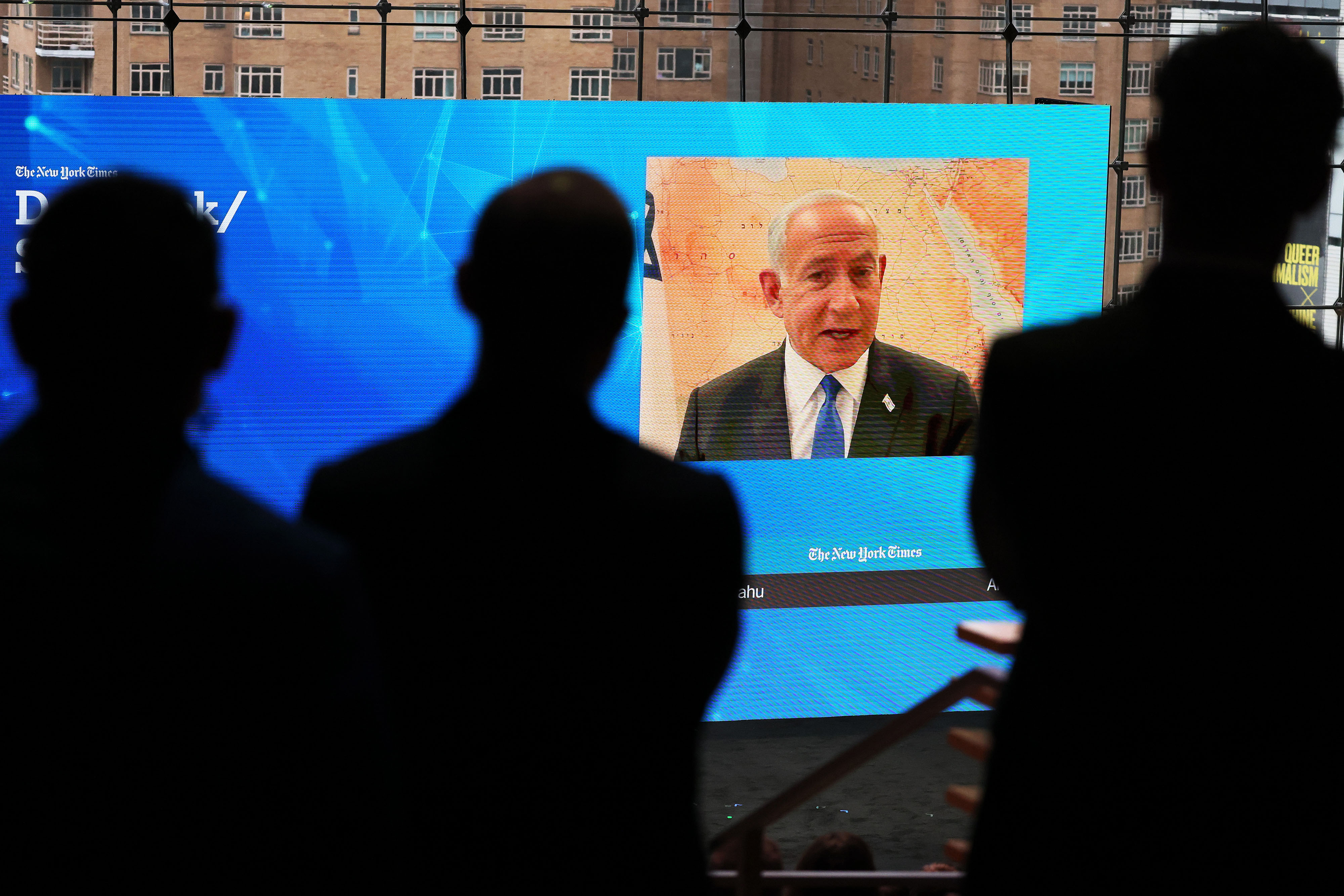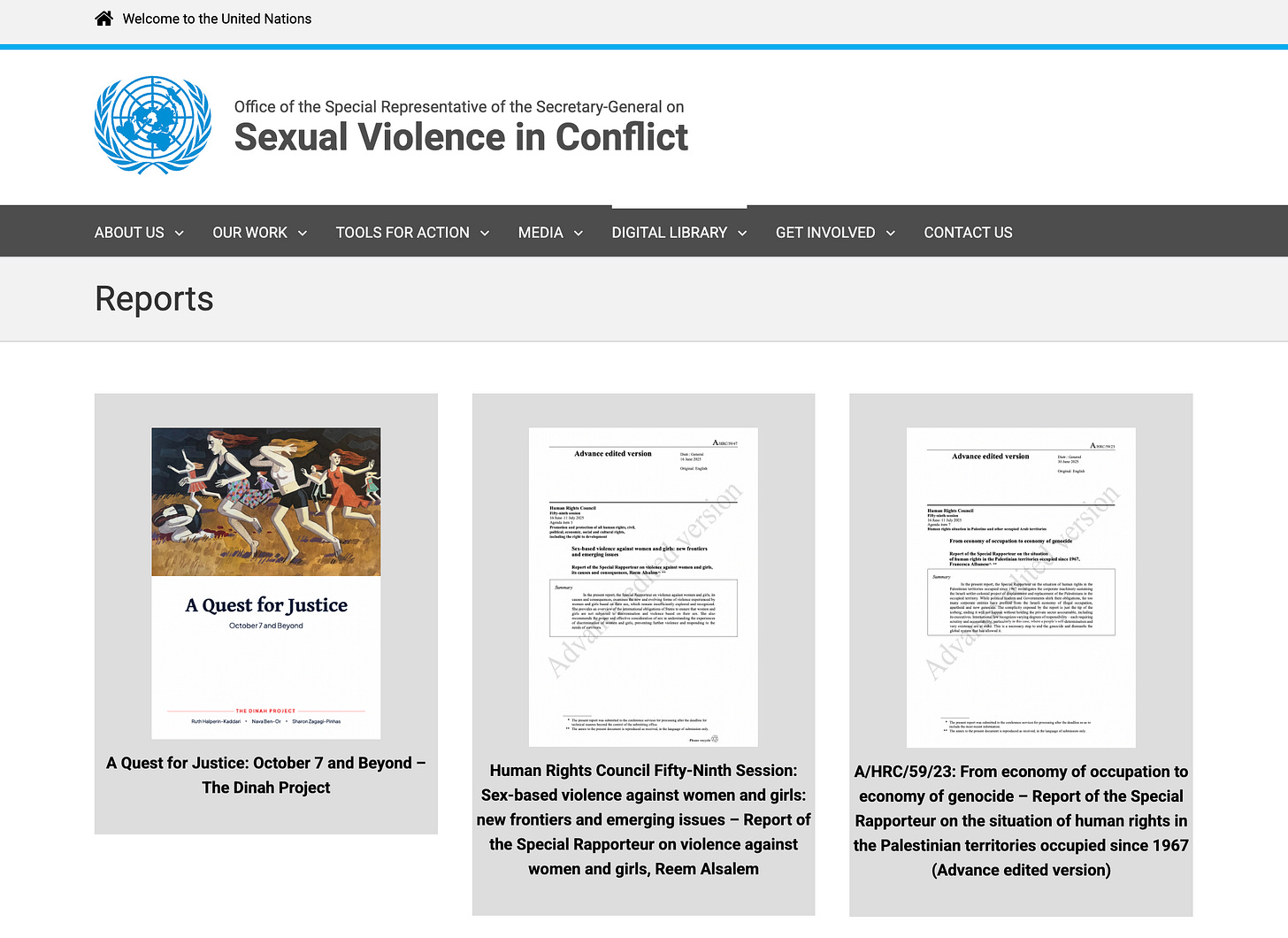My book “The Squad” is out in paperback tomorrow. If you want to get it and avoid Amazon, you can do that here. In hindsight, I regret not fighting for the original title I wanted, “They’ve Got Money,” because it is a sequel to my previous one, “We’ve Got People.” The book isn’t really about The Squad so much as it uses them to tell the story of the left and resistance to establishment power over the past decade. It was written before October 7, but about half of the book is about the AIPAC-financed counter-revolution that rose up to beat back the new energy rising inside the party—energy we saw crest in New York City with the mayoral nomination of Zohran Mamdani this summer. This is a book for anyone who has ever wanted to know exactly how it is that Israel and its supporters amass and spend capital in Washington. And I voiced the audio book, if that’s your thing.
 Benjamin Netanyahu appears at the New York Times DealBook Summit on November 30, 2022 in New York City. Photo by Michael M. Santiago/Getty Images.
Benjamin Netanyahu appears at the New York Times DealBook Summit on November 30, 2022 in New York City. Photo by Michael M. Santiago/Getty Images.
This month, the Dinah Project—an Israeli organization—published a new report widely described in Western media as a thorough look into sexual violence by Palestinian militant groups on October 7, 2023. The document, however, contains scant new evidence and largely aggregates existing reports, many of which have been discredited or called into question. Instead of marshaling new evidence, it argues that less should be needed: The report spends the bulk of its 80 pages presenting a legal argument for a lower evidentiary standard to prosecute Hamas for war crimes over the alleged systematic use of sexual violence as a weapon of war.
Prosecutors, the report argues, should not have to rely on the kind of evidence typically associated with prosecutions—witness or victim testimony, forensic reports and the like—but instead should be able to rely on “circumstantial evidence” and general deductions. And in order to find a pattern of systemic sexual violence, it should be sufficient to identify individual cases of such violence and read into them a systemic nature. Completing the circle, those individual cases need not hold up to the standards of typical prosecutions.
Major news organizations, most prominently the New York Times, have promoted the idea of systematic sexual violence at opportune moments to justify Israel’s ongoing genocide in Gaza. The first major salacious headlines and assertions emerged in late 2023, when Israel was campaigning to restart its killing during a brief ceasefire. The latest effort to revive this narrative follows the same pattern as its predecessors—and, indeed, is more overtly political, with the report spending less airtime on the well-being of women than on reasons we should roll back what is left of international law.
Support reporting you won’t see anywhere else. Subscribe to Drop Site News:
Ruth Halperin-Kaddari, the lead author on the report and an Israeli legal scholar and activist, appeared at a press briefing on July 9 and said that the goal of the report was to get outside organizations to endorse the new report, and use that support to pressure the United Nations. “The hope is to… set the historical record straight and to have it affirmed by as many organizations as possible, and building upon this, continue also on the international political level,” said Halperin-Kaddari. “We are hoping that the Secretary General will indeed follow on and blacklist Hamas.”
Halperin-Kaddari has been largely successful in shaping the global narrative around sexual violence on October 7. In the immediate aftermath of the attack, she recruited her former colleague Pramila Patten, now the United Nations Special Representative on Sexual Violence in Conflict and Under-Secretary-General of the UN, for a trip to southern Israel last year to produce a report on sexual violence. That report is often cited as evidence that the UN sanctions the idea that there was a “pattern” of sexual violence. Yet the report was not remotely conclusive — it did not even have an investigatory mandate—but it still managed to debunk many of the lurid claims being made publicly at the time. Those debunked claims have now resurfaced in the Dinah Project’s new version despite having been knocked down.
The Dinah Project authors understood from the beginning of their project that the lack of evidence or witnesses would present challenges, and so began thinking early on about a new framework to apply guilt to Hamas. “Our goal is to propose a scheme of deducing premeditation from circumstantial evidence, including through comparison to forms of violence that are typical to CRSV,” reads an early Dinah Project mission statement, referring to conflict-related sexual violence. That new evidentiary scheme is fully fleshed out in the new report.
The UN, however, has stated multiple times that it does not have evidence of systematic sexual abuse by Hamas or any other militant group on October 7, 2023. A top United Nations official issued a statement last week that stands in direct contradiction to the new Israeli report. Reem Alsalem, the UN Special Rapporteur on violence against women and girls, affirmed in her statement this week that though the UN had not found “systematic” sexual violence: “It is my understanding that neither the Commission nor any other independent human rights mechanism established that sexual or gender-based violence was committed against Israelis on or since the 7th of October as a systematic tool of war or as a tool of genocide,” Alsalem wrote in the statement, first reported by NBC News.
The demand for lesser scrutiny of evidence comes despite early claims by Halperin-Kaddari, repeated uncritically in Western press reports, that Israel had collected reams of forensic evidence and eye-witness testimony documenting the assaults. Reported The Guardian in January 2024:
Israel’s top police investigations unit, Lahav 433, is still poring over 50,000 pieces of visual evidence and 1,500 witness testimonies, and says it is unable to put a number on how many women and girls suffered gender-based violence.
By cross-referencing testimonies given to police, published interviews with witnesses, and photo and video footage taken by survivors and first responders, the Guardian is aware of at least six sexual assaults for which multiple corroborating pieces of evidence exist. Two of those victims, who were murdered, were aged under 18.
At least seven women who were killed were also raped in the attack, according to Prof Ruth Halperin-Kaddari, a legal scholar and international women’s rights advocate, from her examination of evidence so far. The New York Times and NBC have both identified more than 30 killed women and girls whose bodies bear signs of abuse, such as bloodied genitals and missing clothes, and according to the Israeli welfare ministry, five women and one man have come forward seeking help for sexual abuse over the past few months.
None of the seven cases cited by Halperin-Kaddari were substantiated; not a single verified case emerged from the alleged 50,000 pieces of visual evidence, the 1,500 witness testimonies. Instead, cases that were claimed to have been based on photographic evidence were retracted once the photos were viewed by United Nations staff. The Dinah Project report argues that the traditional approach to prosecuting sexual violence therefore needs to be adapted when it comes to October 7. The report speculates that some victims may have been killed after being assaulted, but the lack of forensic evidence to support such a claim leaves the report’s authors arguing instead that “circumstantial evidence” should be enough to convict.
It is important to emphasize that we are not referring here to eyewitness identification of specific perpetrators. Rather, these testimonies directly establish the occurrence of sexual violence during the attack. Under the model we have set forth regarding the attribution of criminal responsibility, criminal liability of those who took part in the mass attack is understood as joint responsibility, and there is therefore no need to prove a direct link between a specific perpetrator and a specific act of sexual violence or a specific victim. [emphasis in original]
The harm is communal, they argue, and therefore the responsibility is joint.
Though they go to great lengths to stress that there is enough evidence to call sexual violence “systematic,” despite the UN and others rejecting this, they also argue that even one isolated act of sexual violence would be a war crime because the “overall attack” itself was “widespread or systematic”:
Therefore, from a strictly legal perspective, within the definition of Article 7(1)(g) of the Rome Statute, even one act of sexual violence, when perpetrated “as part of a widespread or systematic attack directed against any civilian population, with knowledge of the attack”, can constitute a crime against humanity.17 It is important to note that, in this definition, the element of “widespread or systematic” refers to the nature of the overall attack and not necessarily to the acts of sexual violence committed as part of it. Thus, in order to label CRSV as a crime against humanity, there is no need to prove that the sexual assaults were systematic and premeditated. [emphasis added]
It also doesn’t seem to matter that such standards have not been necessary in other instances of violent conflict. “Traditional approaches to prosecuting sexual violence rely heavily on direct victim testimony, which is often unavailable in conflict settings,” the report claims. That, however, is simply not true. Whether the violence has been carried out in Sudan, Rwanda, Myanmar, or in Israeli detention centers, investigators are indeed able to find direct victims when the sexual assault is systemic.
In a move that is highly unusual, the Dinah Project report is now hosted on the UN’s website among its own reports on sexual violence and global conflict. Drop Site News asked Patten why she was hosting the report, but she did not respond.
 Screenshot of “A Quest for Justice” on the UN website.
Screenshot of “A Quest for Justice” on the UN website.
The argument, if taken up by the UN, “carries concrete implications,” the authors say, principally that it would implicate UN Resolution 1960 and lead to Hamas being added to a UN blacklist for entities that use sexual violence as a weapon of war. Another goal, they say, is also to “impose targeted sanctions.”
“We have to bear in mind that the UN has to date not designated Hamas as a terrorist organization,” Halperin-Kaddari told Ynet. “This is obviously because of political reasons. … Blacklisting Hamas would be one step in finally remedying this totally unacceptable situation, and it would encourage more countries to sanction Hamas. Blacklisting Hamas will finally expose them as rapists and not as freedom fighters.”
UN official Alsalem noted that Israel thwarted any official investigation. The UN’s commission investigating possible sexual violence “was also unable to independently verify specific allegations of sexual and gender-based violence due to Israel’s obstruction of its investigations,” she said.
The UN fact-finding mission led by Patten and so dearly held by the Dinah Project, at times, directly contradicts what the Dinah Project argues.
The [UN] mission team concluded that there were reasonable grounds to believe that conflict-related sexual violence occurred during the October 7 attacks in multiple locations across Gaza periphery, including rape and gang rape in at least three locations, and that there is clear and convincing evidence that hostages in Gaza were subjected to sexual assaults that were probably still ongoing.
The SRSG [Patten, the Special Representative of the Secretary General] clarified that the mission team could not ascertain whether sexual violence was used as a tactic of war or in a widespread and/or systematic manner, due to the limited time at their disposal and because this determination would require a comprehensive, full-fledged investigation.
Nevertheless, the report contains sufficient findings to establish the systematic nature of the sexual violence. Furthermore, it provides enough information to determine that the acts of sexual violence committed by Hamas on October 7 constitute crimes against humanity." [emphasis added]
The push to lower standards of evidence isn’t necessary for some news organizations. NBC News, in its coverage of The Dinah Project, claimed the report includes “testimony from a rape survivor from the Nova music festival.” Yet the Dinah Project does not include such testimony. It does say investigators spoke to a victim of attempted rape, but it is unclear if that assault is what NBC is referring to. NBC News did not respond to a request for explanation.
From Drop Site News via this RSS feed


